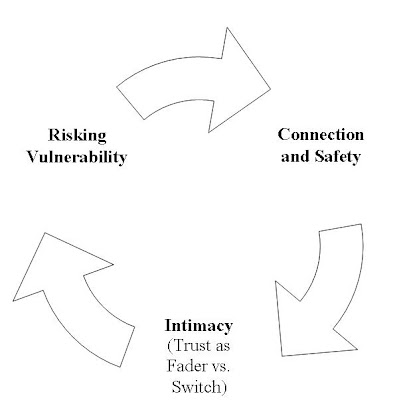by Jonathan Hart, LPC
When a breach has occurred in relationship, one of the hardest pieces to rebuild is trust. There has been hurt, maybe lashing out in both directions, recrimination, guilt, and shame.
One basic tool for understanding how trust is rebuilt is what I refer to as the Intimacy feedback loop.
The first step is “Risking Vulnerability”. This is a hard one. It means choosing to tell, reveal, or do something that makes you feel vulnerable, risking that the other person will have the power to use it to hurt you (again). The challenge is in not risking unwisely. If your counterpart has not shown evidence of being willing to work on things or to be vulnerable in their own turn, you might not be ready to engage in this process. But if both of you are on the same page about building trust and being trust-worthy, then it is time to risk. Start small, be careful and cautious, but risk being vulnerable about something.
The next step is “Connection and Safety”. When one person risks becoming vulnerable and shares something sensitive or fearful, the other has two choices: to receive and hold gently, or to reject and misuse the information. When what is risked is received, heard, and validated, both partners feel closer to each other, and trust begins to grow. When what is risked is rejected or misused, the emotional distance is increased and trust is destroyed exponentially more.
Risk that results in safe connection (trust) leads to Intimacy. Intimacy leads to an increased capacity to risk, and so on around the circle. The building of trust happens incrementally, never all at once. This is especially true when damage has been done within the relationship. The one who has been hurt is rightly cautious of trusting the one who has hurt them. To expect anyone to “get over it” quickly is unreasonable, no matter what “it” is.
The hard task of the one who had done the harm is to receive and absorb this distrust, and to allow for it to be present, even after much has been amended. Acknowledging the hurt, behaving in a way contrary to the hurtful behavior, and to remain patient for healing is all a part of remaining trustworthy, and contributes to the rebuilding of trust. And it will take time.
Trust operates on a fader, not on an “on/off” switch. Sometimes you’ll trust at 40%, and sometimes at 10%. It will slide back and forth. Just because trust is lower today than it was yesterday does not mean it isn’t growing. It may just mean you’re having a bad day and that the pain is closer to the surface. It takes a great deal to totally destroy trust, just as total “100%” trust is impossible to achieve (and is unwarranted, given that we are all fallible human beings!).
Try to hold to the long view of this as a growth process; that with all the ups and downs, as long as you are continuing to hold each other gently and honor each others’ risks, trust will continue to grow between you. Give it the time it needs. Keep on walking the circle.
